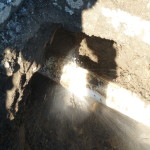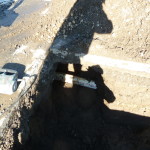The Bus Terminal: A Seattle Leak Detection Story
History
Leakmasters was recently called to a bus terminal for their Leak Detection Seattle services of an underground water leak. The bus terminal has been in operation along the waterfront area for over 20 years. The facility does complete bus repairs and also washing of buses. While they realized they had a break, they did not know where in the 1000 foot long line this break occurred. The pipe involved did not have a tracer wire on it, so there were no records indicating it’s progress underneath the parking lot.
Finding the Problem
Leakmasters has over 40 years of experience in finding and detecting the precise location of leaks. Using ultra sonic listening devices and infrared cameras, we were able to give the owners a location so that with one dig of the parking lot they found the broken 4 inch PVC pipe. The PVC had separated at one of the many glue fittings along the line and had likely been leaking for months. The blue is a leak under a parking lot. The leak would surface under the asphalt and pool water over a large area. The infrared camera would locate the cold area where the main water line was broken, as seen above.
How Seattle Gets its Water
The City of Seattle established a water municipality shortly after the Great Fire of June 6, 1889. Prior to this time, water was supplied by private wells and springs. Water is drawn from the Cedar River Watershed and treated at facilities along the way. The water provides the basis of hydro electric power for Seattle City Light. Additionally the watershed area is important to a diverse range of wildlife, including important salmon spawning areas. Water then flows through large lines connecting to 1,700 miles of water mains, which are propelled by gravity and pumping stations straight to your door.
Quantifying the Water Loss
The main line coming in from the City of Seattle where the break occurred was 1000 feet long and 4 inches in diameter. A pipe this size makes this leak a very difficult job. Water loss was drastic – at a rate of 10 gallons per minute, far more than a smaller line or internal pipe. To put this loss in other terms:
- 10 gallons per minute is equal to 5,259,490 gallons per year according to Google’s calculations.
- At Seattle’s commercial water rates, that would cost an average of $5.44 per 100 cubic feet year round.
- 100 cubic feet equals 748 gallons, so 5259490 gallons = 7031 x 100 cubic feet
- Water loss alone would cost $38,250.84 per year.
Without leak detection, a repair of this size would have cost the business an estimated $35000. The company would have been forced to install an entire new water main. That’s $38,250 in loss plus $35,000 in repairs, which means this water leak would have totaled $73,250 in one year.
In addition to saving on repairs, the City of Seattle will usually credit the owners the overage of the usage once the leak has been located. The owners were able to save money not only in repair costs, but also in water cost credit. Leakmasters can provide Seattle Leak Detection, in addition to service in the greater Puget Sound area including Bellevue, Everett, Issaquah, Redmond, Bremerton, Burien, Whidbey Island, Camano Island, Olympia, Auburn, Bainbridge Island, Port Angeles, and Renton.







